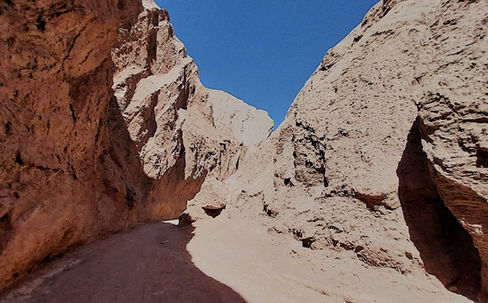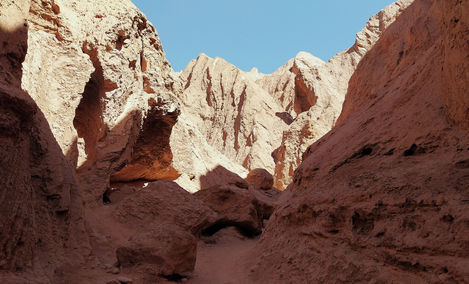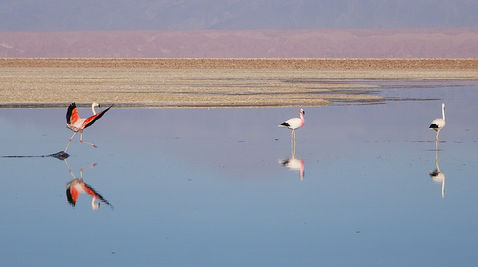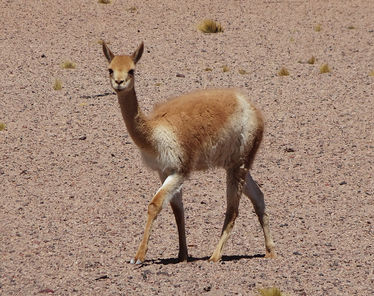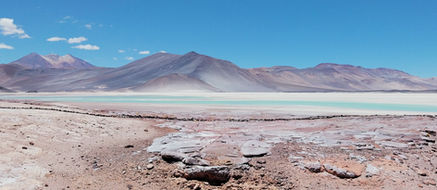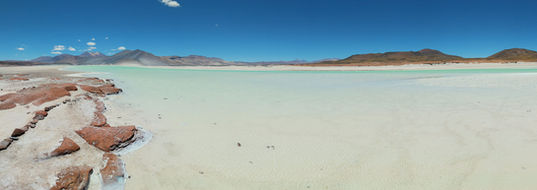
Atacama Desert (Part 1)
Chile
The Atacama Desert is said to be the driest place on earth outside of Antarctica. As we were planning to spend most of our time outdoors, being almost assured of clear blue skies and no rain definitely worked in our favour. Scientists claim that the soil quality is so similar to Mars that NASA performs experiments in this region. We were expecting an otherworldly experience during our time here.
Day 1 gave us a cloudless conditions and searing heat - vastly different to the dreary conditions of the UK, where we had spent the last 2 months. We based ourselves in the laid-back touristy town of San Pedro de Atacama, sitting at 2,400 m. Our car rental from the airport had fallen through, so instead we hired mountain bikes for the day and set off for the Valle de la Luna (Valley of the Moon). Coming from sea level with no time to acclimatise to the altitude, our lungs were screaming at the slightest of inclines. I hadn't wheezed this heavily in a long time. The added resistance of the rock, gravel and sand roads only intensified the pain.
First stop was the Sand Dunes, where a hiking trail led us along a ridge with rocky mountains on one side and a long, dark dune on the other. Around every corner we saw a different pattern in the sand, although the dune looked out of place among the jagged rocks. Nearby were the Achaches miradors, each of which offered a vastly different outlook over the desert. From one viewpoint we gazed at the dunes we had just walked by but from the opposite end, while from another lookout we saw what looked like a gigantic crater in the valley floor, known as the Amphitheatre. It wasn't hard to see why it was called the Valley of the Moon.
Further down the road was a very small, shallow salt mine, where embedded in the walls were chunks of salt glistening in the sun. We stopped and listened to the salt cracking as the crystals expanded in the rocks in heat of the day. The sound reminded me of boats gently knocking against a pier in the water. Around here white streaks ran through the landscape, changing the scenery yet again.
Finally, we ventured out to the Tres Marias, an odd-shaped quartz and granite rock, eroded by salt and wind to create 3 pillars. In my opinion, they weren’t really worth the extra 2 km ride. After a quick break, we turned around to make the long bike ride out of the valley and back to town, with the sun beating down and dehydration setting in.

After lunch I rode out alone to Gargantua del Diablo (Devil's Throat), only a few kilometres north of town. Danny had expended all his energy in this morning's ride, so he sat this one out. Turning off the main road I entered a narrow canyon, the walls twisting and turning as they guided me further into the valley. The mid-afternoon sun created contrasting shadows on the rocks, forcing me to stop every minute or so to take another photo. I was warned at the entrance I would have to lift my bike up and down natural steps through the canyon, but there was no warning that some of these would be half a metre tall with no room to stand beside the bike. That meant I had to lift from the front or push from behind, which was incredibly awkward. It wasn't long before I decided to ditch the bike and walk the rest of the way.
The canyon ended after 2 km at a sign pointing towards a mirador. A lengthy, steep climb up a rocky mountain (another long-buster) ended in a sensational viewpoint back over the canyon. Spread out across the valley were a ripple of short, sharply rutted rocks, giving the appearance of scrunched up paper. Behind me was the perfectly conical Licancabur Volcano, sitting on the Bolivian border and calling out to be climbed. It was a mesmerising sight.
Later in the day we returned to Valle de la Luna for sunset (we had managed to secure a car by this stage, saving our weary legs from another bike ride). Hundreds of people had flocked to the 2 viewpoints, Piedra de Coyote and Mirador Cari, only a couple of minutes walk from each other. We flitted between both sites, watching the shadows deepen on the wavy rocks in valley and the sun slowly set behind distant mountains. In the opposite direction a full moon was rising behind Licancabur Volcano, which was just as photoworthy. It wasn't the most colourful sunset we had ever witnessed but it was well worth the effort.


The next morning we woke early for a sightseeing trip down south. As public transport isn’t an option for travelling around the Atacama, we were thankfully able to rent a car at the last minute for 2 days. First stop on our itinerary was Laguna Chaxa, home to a large flock of flamingos. All of our research online told us the drive would take just under 2 hours. We were there in 40 minutes, pulling up to a locked entrance gate an hour before it opened.
Once we could eventually enter, we followed a salt-crusted path around an expansive plateau of short, jagged rocks that looked like they would tear your skin to shreds. Informational signs reeled off various facts about the region, which were slightly interesting but we were just there for the birds.
At last we arrived at the lagoon, where hundreds of flamingos were wading through the shallow water and eating breakfast. The sun was still low in the sky, the light creating perfect reflections in the glass-like surface. Even though the flamingoes didn't do much, they were fascinating to watch.

Another hour or so down the road were two lagoons, Miscanti and Miñiques. Along the way the landscape changed from the grey-brown Martian scenery we had become accustomed to, to a bright yellow-green colour, with tufts of grass adding some much needed contrast to the soil. Previously distant mountains were suddenly right in front of us as we slowly ascended towards the lakes. After the scorching heat of yesterday, we were not expecting the cold blast of air that hit us when we exited the car. With the elevation being 4,200 m though, we shouldn't have been surprised.
Laguna Miscanti was vibrantly blue and glistened in the sun. Laguna Miñiques, on the other hand, was much smaller in size, ringed by salt and deeper in colour. Despite being beautiful they weren't the most exciting lakes we had visited (more hiking trails around the edge would have been appreciated). The presence of several vicuñas munching on the grass increased our opinion of the area slightly.
It was another long drive to Salar de Talar (aka Salar de Aguas Calientes) and the Piedras Rojas. A milky blue salt flat (the Salar part) was surrounded by a series of mountains and volcanoes that formed a dramatic backdrop. A long path from the car park meandered through an area of deep red rocks (the Piedras Rojas part), which eventually led us right to the water's edge. We weren't allowed to touch the water, but knowing the water was warm (the Aguas Calientes part) made it hard to resist. A howling wind followed us the entire time we were here, so we didn't stay long.
On our way back to San Pedro de Atacama we detoured via another couple of lakes. The Ojos de Salar (Eyes of the Salt Flat) were basically 2 tiny ponds on either side of the road that didn't hold our attention for long. Nearby was Laguna Tebinquiche, a large expanse of pale light blue water that was covered in massive patches of salt. The salt was so white that it looked like a layer of ice sitting on the surface. If they could somehow combine the flamingos of Laguna Chaxa with the scenery here, it would have been the ultimate site to visit.




















